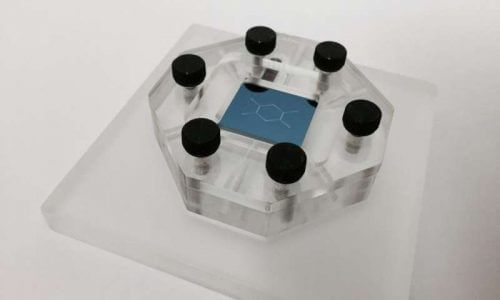IBM scientists will collaborate with the Icahn School of Medicine at Mount Sinai Hospital in conducting experiments on prostate cancer using the new kit. The article was published in the journal Nature Nanotechnology

IBM scientists have developed a new lab-on-a-chip technology that can separate, for the first time, biological particles at the nano level, and that will allow doctors to diagnose diseases such as cancer, before their symptoms appear.
As reported this week in the journal Nature Nanotechnology, the results of IBM's work showed separation of biological particles based on size down to a diameter of 20 nanometers. On this scale it is possible to locate important particles such as DNA sequences, viruses and particles secreted from the cells into the body fluids (exosomes). The goal is for these particles, once separated, to be tested by doctors to reveal signs of disease, even before patients experience any physical symptoms and while treatments are yielding the best results. Until now, the smallest biological particle that could be separated according to its size with on-chip technologies was approximately 50 times larger or more - such as, for example, the separation of cells that were released from tumors and migrated in the blood circulation - from other biological components.
IBM is collaborating with a team from Mount Sinai Hospital's Icahn School of Medicine to further develop this lab-on-a-chip technology, and it plans to test it on prostate cancer, the most common cancer among men in the US.
In the era of precision medicine, the importance of exosomes as biomarkers that help in the diagnosis and diagnosis of malignant tumors is increasing. Exosomes are released into body fluids such as blood, saliva or urine, which can be obtained relatively simply. They represent a valuable biomedical tool, since they can be used in the context of less invasive liquid biopsies to reveal the origin and nature of the cancer.
The IBM team focused with its devices on exosomes since current devices have difficulty separating and distilling exosomes in liquid biopsies.
The size of exosomes ranges from 20-140 nanometers, and they contain information regarding the health of the cell of origin from which they were secreted. Determining the size of exosomes, the proteins and nucleic acids they carry, can provide vital information regarding the presence and status of cancerous tumors and other diseases.
The results obtained by the IBM team show that it can separate and locate particles up to 20 nanometers in size from smaller particles, that exosomes with a size of 100 nanometers or more can be separated from smaller exosomes, and that the separation can be performed despite the effects of diffusion, the hallmark of Particle movement on this small scale. Together with the Mount Sinai Hospital, the IBM team plans to verify that the device in its hands is able to locate exosomes with specific cancer biomarkers, in liquid biopsies of patients.
With the ability to sort biological particles at the nano level, the Mount Sinai Hospital hopes that IBM's technology will provide a new method to eavesdrop on the messages transmitted by the exosomes in the intercellular communication. In this way, it will be possible to answer important questions regarding the biological basis of various diseases, and also pave the way towards non-invasive diagnostic tools, which will eventually be available to all patients. Monitoring these intercellular "conversations" on a regular basis can allow medical experts to monitor the patient's health status or the progress of the disease from which he is suffering.

4 תגובות
Yossi - talking about nano drugs. Your idea is not so science fiction.
sounds interesting. If Professor Haik doesn't hurry (said with good intentions and not with racism) they will catch him.
I wonder why there are no techniques of injecting chemotherapeutic agents into the cancerous tumor. After all, this can be done easily and it can also be monitored "live" with ultrasound.